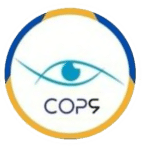You have made an appointment with a contactologist, or you would like to make one, but you are wondering how these appointments take place? The COP9 team presents the 3 types of contactology appointment: the pre-fitting check-up, the lens fitting and the control of the fitting. Read on for more details!

1st type of contactology appointment: pre-adaptation check-up
Many visual defects and pathologies require a first appointment in contactology, such as presbyopia, astigmatism, myopia, hyperopia… Lenses can correct or improve a specific ocular need. In this article, we have already mentioned the profession and the pathologies treated by this vision specialist.
When you make an appointment in contactology, this first meeting allows us to perform what we call a pre-adaptation check-up.
During the pre-adaptation check-up, the contactologist :
- carries out the measurement of the characteristics of the eye (the field of vision, the dioptres, etc.);
- examines the ocular surface (radius of curvature, refraction, etc.);
- defines the type(s) of contact lenses to be worn or avoided (soft lenses, rigid lenses etc.).
Many criteria come into play when choosing the type of contact lens: lifestyle and profession, age, the tear quality, the diameter of the cornea…
Following this first contactology appointment, if there are no contraindications, you will meet the specialist again to carry out the next step: the adaptation to the lenses. Read on to learn more!
2nd type of contactology appointment: lens adaptation
During this 2nd type of appointment, two important steps are carried out:
- Trial lenses are placed on your eyes in order to get used to them and observe your tolerance to them;
- The hygiene rules are explained to you as is the duration of wearing contact lenses.
Lens care is very important to protect you from any infectious risks. The oxygenation of your eyes through the lenses depends on their condition and the removal of all traces of bacteria.
You will learn the correct way to wash your hands, then your lenses with the right cleaning product. Finally, the contactologist will explain how to handle them properly and store them in their case.
During this adaptation time, the contactologist will inform you about the risks of wearing corrective lenses for a long time. You will be asked to use saline solution if your eyes feel dry, or even to remove the lenses and wear your glasses.
This stage of the contactology appointment is therefore just as important as the contact lens fitting stage.
The COP9 team would like to inform you about the duration of this type of contactology appointment: it is the longest because it is about lens adaptation. Count on average two hours at the clinic for everything to go smoothly!
At the end of the evaluation period, which depends on the type of lenses to be tried, the contactologist verifies that the trial lenses are suitable for the patient.
Once the appointment is over, the contactologist will write a prescription for the adaptation lenses. This prescription is to be given to the optician who will order them. A detailed information sheet on lens care rules is also provided, summarizing everything that was discussed during the second contactology appointment.
3rd type of contactology appointment: the adaptation control
This third type of appointment is usually made one month after the second one. The adaptation control allows for personalized follow-up care, in consultation with the ophthalmologist, regardless of the visual disorder being treated.
This is the moment to mention if your eyes have been irritated while wearing the lenses, or if there has been any other type of discomfort. If this is the case, another contactology appointment for lens adaptation will be scheduled.
If, on the other hand, everything has gone well and the corrections correspond to your needs, the contactologist will write you a prescription for permanent lenses.
On this prescription will be indicated:
- the contact lens references (hard lenses, toric lenses, progressive lenses, etc.);
- the cleaning product to be used ;
- duration of wearing ;
- renewal (daily, bi-monthly, monthly lenses…);
- a reminder of the rules of hygiene.
All that is left for you to do is to go to an optical center to order your permanent lenses and to follow the instructions. We would like to draw your attention to the importance of following the prescription to renew your lenses frequently.
In conclusion, the 3 types of contactology appointments allow to ensure a safe adaptation to contact lenses, the discovery of the hygiene rules and the associated cleaning products, and to avoid any complications. Finally, contact lens wearers, if after these appointments you feel any dryness, irritation, or that your lenses are no longer comfortable, don’t hesitate to make another appointment with your contactologist or your ophthalmologist!
